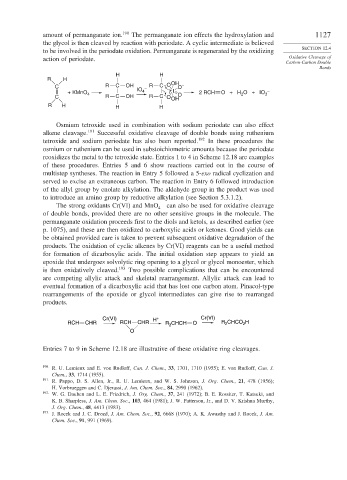Page 1151 - Advanced Organic Chemistry Part B - Reactions & Synthesis
P. 1151
amount of permanganate ion. 190 The permanganate ion effects the hydroxylation and 1127
the glycol is then cleaved by reaction with periodate. A cyclic intermediate is believed
SECTION 12.4
to be involved in the periodate oxidation. Permanganate is regenerated by the oxidizing
action of periodate. Oxidative Cleavage of
Carbon-Carbon Double
Bonds
H H
R H
C R C OH IO – R C O OH O –
+ KMnO 4 4 I 2 RCH O + H O + IO 3 –
2
C R C OH R C O OH O
R H H H
Osmium tetroxide used in combination with sodium periodate can also effect
alkene cleavage. 191 Successful oxidative cleavage of double bonds using ruthenium
tetroxide and sodium periodate has also been reported. 192 In these procedures the
osmium or ruthenium can be used in substoichiometric amounts because the periodate
reoxidizes the metal to the tetroxide state. Entries 1 to 4 in Scheme 12.18 are examples
of these procedures. Entries 5 and 6 show reactions carried out in the course of
multistep syntheses. The reaction in Entry 5 followed a 5-exo radical cyclization and
served to excise an extraneous carbon. The reaction in Entry 6 followed introduction
of the allyl group by enolate alkylation. The aldehyde group in the product was used
to introduce an amino group by reductive alkylation (see Section 5.3.1.2).
The strong oxidants Cr(VI) and MnO − can also be used for oxidative cleavage
4
of double bonds, provided there are no other sensitive groups in the molecule. The
permanganate oxidation proceeds first to the diols and ketols, as described earlier (see
p. 1075), and these are then oxidized to carboxylic acids or ketones. Good yields can
be obtained provided care is taken to prevent subsequent oxidative degradation of the
products. The oxidation of cyclic alkenes by Cr(VI) reagents can be a useful method
for formation of dicarboxylic acids. The initial oxidation step appears to yield an
epoxide that undergoes solvolytic ring opening to a glycol or glycol monoester, which
is then oxidatively cleaved. 193 Two possible complications that can be encountered
are competing allylic attack and skeletal rearrangement. Allylic attack can lead to
eventual formation of a dicarboxylic acid that has lost one carbon atom. Pinacol-type
rearrangements of the epoxide or glycol intermediates can give rise to rearranged
products.
Cr(VI) H + Cr(VI)
RCH CHR RCH CHR R CHCH O R CHCO H
2
2
2
O
Entries 7 to 9 in Scheme 12.18 are illustrative of these oxidative ring cleavages.
190 R. U. Lemieux and E. von Rudloff, Can. J. Chem., 33, 1701, 1710 (1955); E. von Rudloff, Can. J.
Chem., 33, 1714 (1955).
191
R. Pappo, D. S. Allen, Jr., R. U. Lemieux, and W. S. Johnson, J. Org. Chem., 21, 478 (1956);
H. Vorbrueggen and C. Djerassi, J. Am. Chem. Soc., 84, 2990 (1962).
192 W. G. Dauben and L. E. Friedrich, J. Org. Chem., 37, 241 (1972); B. E. Rossiter, T. Katsuki, and
K. B. Sharpless, J. Am. Chem. Soc., 103, 464 (1981); J. W. Patterson, Jr., and D. V. Krishna Murthy,
J. Org. Chem., 48, 4413 (1983).
193
J. Rocek and J. C. Drozd, J. Am. Chem. Soc., 92, 6668 (1970); A. K. Awasthy and J. Rocek, J. Am.
Chem. Soc., 91, 991 (1969).

